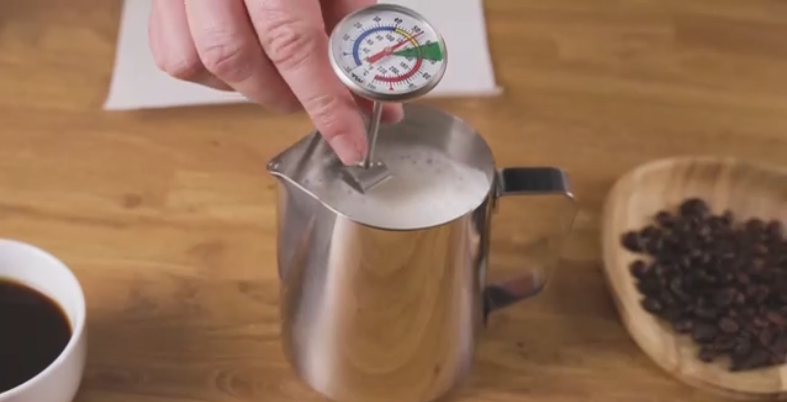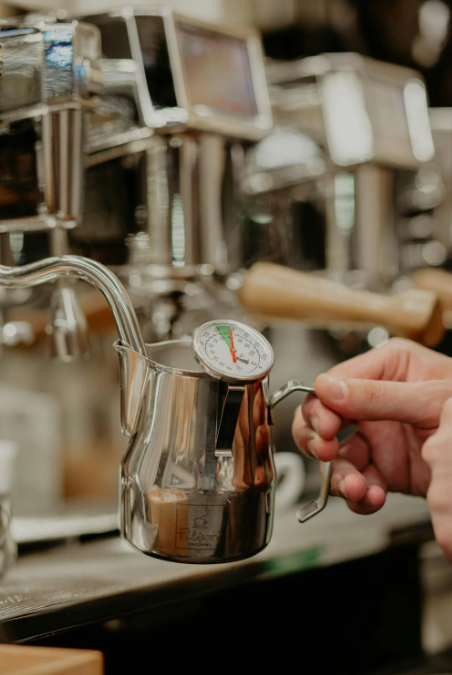The Ultimate Guide to Steaming & Frothing Milk for Coffee: The Right Tools & Techniques
Whether you’re a home barista or a professional, mastering the art of steaming and frothing milk is key to creating delicious coffees. Knowing the difference between steamed and frothed milk is essential. Furthermore, different styles of coffee use either steamed, frothed or both. For example, an espresso macchiato uses just frothed milk. So, knowing when each method of adding milk is more important than you may have thought. Plus having the right tools like a quality stainless steel milk jug, a precise milk thermometer can make all the difference.
This guide covers:
- The difference between steamed and frothed milk
- Step-by-step techniques for steaming and frothing
- How much milk and what type of milk different types of coffee drinks needs e.g cappuccino
- Why using a proper milk jug and thermometer matters

What’s the Difference Between Steamed and Frothed Milk?
While both involve incorporating air into milk, they serve different purposes. They are very similar but can make all the difference when making a specific type of coffee drink. Some coffees use just steamed milk like a cortado, some coffees use just milk foam like an espresso macchiato, some use both, like flat whites and cappuccinos. Therefore, it’s important to know the difference.
- Steamed Milk is created with a steam wand, producing a smooth, creamy texture with very fine micro foam. The steam wand is placed further from the surface of the milk in the jug than for frothed milk, so that big air bubbles are expelled and the air is evenly spread throughout the milk.
- Frothed Milk introduces more air, resulting in a lighter, foamier texture with larger bubbles. The steaming wand is placed nearer to the surface of the milk jug, to create airier milk. It works well for cappuccinos.
Using a properly designed milk jug with a precision spout helps control texture, whether aiming for silky steamed milk or airy froth, and is perfect for creating latte art.

Step by Step Guides:
How to Steam Milk like a Barista

Steamed milk is essential for lattes, flat whites, and mochas. The right technique ensures a smooth texture without large bubbles.
Step-by-Step Steaming Guide
- Use a high-quality milk jug and fill it one-third full to allow space for expansion.
2. Use a thermometer to maintain a milk temperature of 55–65°C (130–150°F). Overheating milk can ruin its sweetness and texture.
3. Next, purge the steam wand briefly before steaming to remove any condensation.
4. Position the steam wand just below the milk’s surface and introduce a small amount of air. A soft hissing sound indicates micro foam is forming.
5. Lower the steam wand slightly and tilt the jug to create a whirlpool effect, which smooths out the foam and removes large bubbles.
6. Stop steaming when the milk jug becomes too hot to hold for more than three seconds, or when your thermometer reaches the correct temperature.
7. Tap and swirl the milk jug to eliminate any remaining bubbles and achieve a glossy, uniform texture.
How to Froth Milk for a Fluffy Foam

Frothed milk is used in drinks that require more aeration, such as cappuccinos and macchiatos.
Step-by-Step Frothing Guide
- Use the same setup as steaming, including a quality milk jug and thermometer.
2. Introduce more air by keeping the steam wand near the milk’s surface for a longer period (six to ten seconds). This allows the milk to expand and form a light, airy foam.
3. Once the milk has doubled in volume, lower the steam wand slightly to distribute heat evenly.
4. Stop frothing when the thermometer reads between 55–65°C (130–150°F).
5. Let the milk sit for ten seconds so the foam can separate from the liquid before spooning or pouring the frothy foam onto the coffee.
Milk to Coffee Ratios: How much and what type of milk does different types of coffee drinks need?
Each coffee drink requires a different milk-to-foam ratio. This table provides a quick reference:
| Drink | Country | Amount | Steamed or Frothed? |
| Cappuccino | Italy | Equal parts espresso, steamed milk and frothed milk | Equal Layers of frothy and steamed milk |
| Flat White | Australia / New Zealand | 1:1 coffee to steamed milk, with thin layer of milk foam | Steamed and small amount frothy |
| Espresso Macchiato | Italy | 1:1 espresso to frothed milk. 2-3 spoonfuls of foam | Frothed (dry foam) |
| Cortado | Spain | 1:1 espresso to steamed milk | Steamed |
| Mocha | Yemen | Thin layer (1-2cm) | Steamed (smooth, velvety) |
Why the Right Tools Matter

A Proper Milk Jug for Better Control
- A well-designed stainless steel milk jug with an ergonomic handle and precision spout makes a significant difference when steaming or frothing milk.
- Provides better control over aeration and pouring
- Prevents spills and uneven frothing
- Improves latte art precision
A Thermometer for Consistency
- Using a thermometer ensures milk is heated to the optimal temperature, preventing scalding and maintaining sweetness.
- Helps achieve consistent results every time
- Prevents overheating, which affects taste and texture
- Thermomters are essential for both home and professional baristas

A Cocoa Powder Shaker for the Finishing Touch
- Adding a final dusting of cocoa, cinnamon, or matcha with a powder shaker enhances both the flavour and presentation of drinks.
- Adds a professional touch to cappuccinos, mochas, and latte art
- Provides a quick and even distribution of toppings
Common Milk Frothing and Steaming Mistakes (And How to Fix Them)
- Milk is too bubbly or foamy? The steam wand was too close to the surface for too long. Lower it slightly to create finer micro foam.
- Milk is too thin and lacks foam? Not enough air was introduced. Keep the steam wand near the surface for a few extra seconds.
- Milk overheats too quickly? Lower the steam wand position and use a thermometer to monitor the temperature.
- Froth collapses quickly? Milk might be too old, or a low-fat alternative that doesn’t hold foam well was used.
Final Thoughts: Elevate Your Coffee Game with the Right Tools
Knowing the type and amount of milk you need for your chosen coffee style is essential. Perfectly steamed or frothed milk enhances flavour, texture, and presentation. Whilst, technique is important, using a high-quality milk jug and a precise thermometer ensure consistently professional results.
So, investing in the right tools makes the steaming and frothing process easier, whether you’re making coffee at home or in a café.

